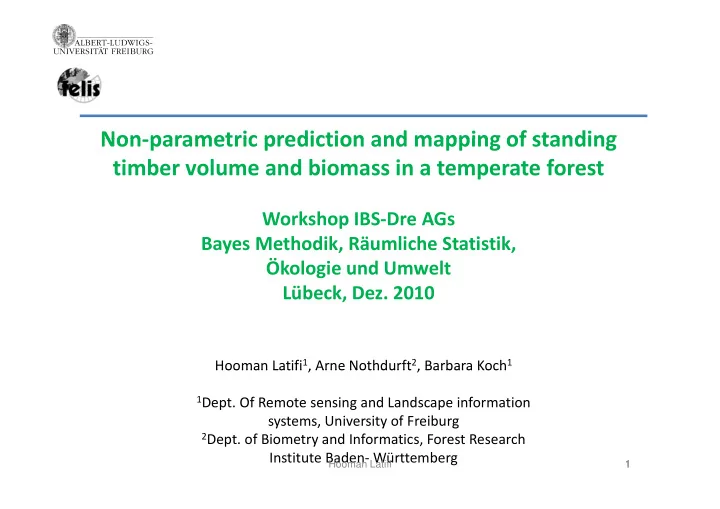

Non parametric prediction and mapping of standing Non-parametric prediction and mapping of standing timber volume and biomass in a temperate forest Workshop IBS-Dre AGs Bayes Methodik, Räumliche Statistik, Ökologie und Umwelt Lübeck, Dez. 2010 Hooman Latifi 1 , Arne Nothdurft 2 , Barbara Koch 1 Hooman Latifi , Arne Nothdurft , Barbara Koch 1 Dept. Of Remote sensing and Landscape information systems, University of Freiburg y , y g 2 Dept. of Biometry and Informatics, Forest Research Institute Baden- Württemberg Hooman Latifi 1 1
Overview Goal Goal: Spatial predictions of Forest Variables, standing timber volume and biomass by non-parametric regression models volume and biomass by non parametric regression models Testing of various distance measures Variable selection Data: Forest Inventory data (design attributes) Remote sensing data (predictor variables) Remote sensing data (predictor variables) Methods: Non-parametric regression models Results: Results: Performance (Bias, RMSE) Variable Selection Hooman Latifi 2
Data Forest Inventory F t I t Data from a forest inventory were collected on permanent circular sample plots in summer 2006 i l l l t i 2006 100 × 200 m sample grid The tree timber volume was calculated using the The tree timber volume was calculated using the taper functions of Kublin (2003) Tree biomass with Zell’s (2008) parameters for Tree biomass with Zell s (2008) parameters for the allometric equation Hooman Latifi 3
Data F Forest Inventory t I t Original 386 forest inventory sample plots y p p 297 complete reference sample plots were used means from the two data sets were not significantly different (t test) different (t-test) prediction at plot-scale Hooman Latifi 4
Data R Remote Sensing t S i The multispectral data Useful for the delineation of vegetation covers The active remote sensing data (e.g. LiDAR altimetry) For characterization of highly variable forest canopy structures (Koukoulas & Blackburg, 2005,IEEE Trans. Geo. Rem. Sens; Hudak et al., 2008,RSE). Hooman Latifi 5
Data R Remote Sensing t S i Hooman Latifi 6
Data R Remote Sensing t S i Optical data CIR orthoimages Thematic Mapper imagery small footprint LiDAR data (first-and-last pulses) (first and last pulses) Height intensity Hooman Latifi 7
Data Remote sensing data g LiDAR (light detection and range) Visualized first-pulse LiDAR point cloud at a LiDAR point cloud at a sample plot level Hooman Latifi 8
Methods N Non-parametric regression t i i the non-parametric k-nearest neighbor estimator with weights with weights denoted as Nadaraya-Watson-estimator: y with uniform kernel estimator of variable bandwidth and distance between the vector of p variables and distance between the vector of p variables for the target unit and its k -th neighbor 9 Hooman Latifi
Methods N Non-parametric regression t i i di distance measure E Euclidian distance lidi di Mahalanobis distance Hooman Latifi 10
Methods Non-parametric regression N t i i distance measure most similar neighbor i il i hb MSN distance canonical coefficients canonical correlation coefficients response variables regressor variables Hooman Latifi 11
Methods N Non-parametric regression trees, Random Forests t i i t R d F t In Random Forests (Breiman, 2001), the NNs are obtained by numerous solutions (forests) of classification trees. The distance is calculated as one minus the proportion of terminal nodes from all regression trees where the target observation is in the same terminal node as the specific reference unit Hooman Latifi 12
Methods V i bl Variable selection l ti -The genetic algorithm g g (GA) applied for variable reduction is a variable reduction is a search method that is based on the principle based on the principle of evolution by natural selection selection. (Trevino & Falciani, 2006) Hooman Latifi 13 [image removed]
Results I I- variable selection i bl l ti - GA search: - Stepwise selection: 11 variables for 5 predictors for timber volume (7 timber volume (4 ti b l (4 from LiDAR 21 predictors for from LiDAR) 4 predictors for 4 di t f biomass (15 from biomass (3 from LiDAR) mostly from FR LiDAR) LiDAR) All from FR height data h i ht d t height data Hooman Latifi 14
Results I I- variable selection i bl l ti Hooman Latifi 15
Results II NN II- NN predictions di ti Hooman Latifi 16
Results II NN II- NN predictions di ti Hooman Latifi 17 17
Results II NN II- NN predictions di ti Hooman Latifi 18 18
Results II NN II- NN predictions di ti Hooman Latifi 19 19
Results III- spatial predictions over the whole area p p (gridding) Predictions of timber Predictions of timber volume (left) and total biomass (right) total biomass (right) by -RF method - smoothed by An Epanechnikov-kernel with 100 m bandwidth Hooman Latifi 20
Discussion and Conclusion Variable selection based on GA search was superior to stepwise selections GA-selected variables (stabilized by a high solution rate ) led to higher precision when applying Euclidean and Mahalanobis distances. MSN and Random Forests worked better with the full regressor variable set LiDAR-data were of major relevance Hooman Latifi 21
Discussion and Conclusion All the applied methods yielded approximately unbiased predictions (Bias% <2%) Some of the forest stands have a dense understory, mainly composed of deciduous species, which may be a potential source of error in height metrics estimation Further research: Could the height metrics extracted from rasterized LiDAR ld h h h d f d forms improve the results?! Hooman Latifi 22 22
Thank you! Acknowledgements: B.Walters (Michigan state University) N.L. Crookston (USDA forest service) Hooman Latifi 23
Recommend
More recommend